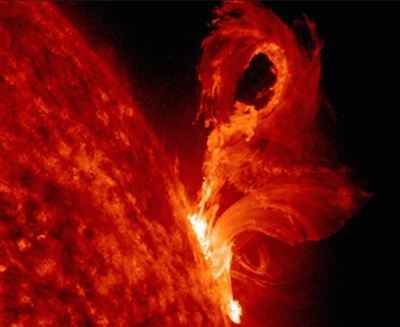- News
- Science News
- Chandrayaan 2's orbiter observes solar flares, will help understand Sun better
This story is from October 11, 2019
Chandrayaan 2's orbiter observes solar flares, will help understand Sun better
A payload on board Chandrayaan-2’s orbiter, circling the Moon’s orbit at 100km, has measured solar flares between September 30 and October 1, which will help scientists better understand various processes on the Sun. Currently, the solar cycle is heading towards minima and the Sun has been extremely quiet for the past few months. Therefore, XSM could observe a series of small flares.

Solar flare
NEW DELHI: One of the eight scientific payloads on board Chandrayaan-2’s orbiter, circling the Moon’s orbit at 100km, has measured solar flares between September 30 and October 1, which, in turn, will help scientists better understand various processes on the Sun.
The payload, solar X-ray monitor (XSM), which detected the solar flares, is capable of measuring X-rays emitted by the Sun and its corona, and can also measure the intensity of solar radiation.Its primary objective is to provide X-ray spectrum in the energy range of 1-15 keV, according to Indian Space Research Organisation (Isro).
 Chandrayaan-2's orbiter circling the Moon
Chandrayaan-2's orbiter circling the Moon
Currently, the solar cycle is heading towards minima and the Sun has been extremely quiet for the past few months. Therefore, XSM could observe a series of small flares between September 30 and October 1.
 The graph showing solar flare measurement taken by the orbiter's payload solar X-ray monitor (XSM)
The graph showing solar flare measurement taken by the orbiter's payload solar X-ray monitor (XSM)
What is a solar flare?
Many violent phenomena keep occurring on the surface of the Sun and its atmosphere known as the corona. This solar activity follows an 11-year cycle, which means, it goes through its ‘solar maxima’ and ‘solar minima' once every 11 years. While the cumulative emission of solar X-rays emitted over a year varies with the solar cycle, these are often punctuated with extremely large X-ray intensity variations over very short periods, few minutes to hours. Such episodes are known as solar flares.
The payload, solar X-ray monitor (XSM), which detected the solar flares, is capable of measuring X-rays emitted by the Sun and its corona, and can also measure the intensity of solar radiation.Its primary objective is to provide X-ray spectrum in the energy range of 1-15 keV, according to Indian Space Research Organisation (Isro).

Currently, the solar cycle is heading towards minima and the Sun has been extremely quiet for the past few months. Therefore, XSM could observe a series of small flares between September 30 and October 1.
The orbiter also uses X-rays emitted by the Sun in a clever way to study elements on the lunar surface. Solar X-rays excite atoms of constituent elements on the lunar surface. These atoms when de-excited emit characteristic X-rays (a fingerprint of each atom). By detecting the characteristic X-rays, it becomes possible to identify various major elements of the lunar surface. However, to determine their concentration, it is essential to have simultaneous knowledge of the solar X-ray spectrum. The orbiter’s Large Area Soft X-ray Spectrometer (CLASS) and XSM payloads can measure the lunar elemental composition using this technique. While CLASS detects the characteristic lines from the lunar surface, XSM simultaneously measures the solar X-ray spectrum.

What is a solar flare?
Many violent phenomena keep occurring on the surface of the Sun and its atmosphere known as the corona. This solar activity follows an 11-year cycle, which means, it goes through its ‘solar maxima’ and ‘solar minima' once every 11 years. While the cumulative emission of solar X-rays emitted over a year varies with the solar cycle, these are often punctuated with extremely large X-ray intensity variations over very short periods, few minutes to hours. Such episodes are known as solar flares.
End of Article
FOLLOW US ON SOCIAL MEDIA
